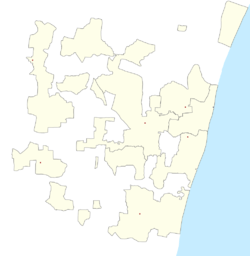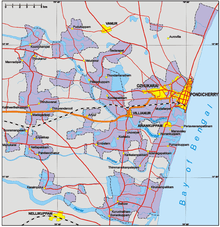Puducherry district
The Puducherry district, also known by its former name Pondicherry district, is one of the four districts of the Union territory of Puducherry in southern India. The district occupies an area of 290 square kilometres (110 sq mi),[2] spread over 11 non-contiguous enclaves lying on or near the Bay of Bengal within a compact area in the state of Tamil Nadu. According to the 2011 census, the district has a population of 950,289.[3]
Puducherry district | |
|---|---|
District of Puducherry | |
 Puducherry district Pondicherry in Puducherry  Puducherry district Puducherry district (India) | |
| Coordinates: 11°55′N 79°49′E | |
| Country | |
| State | Puducherry |
| Headquarters | Pondicherry |
| Taluks | Ariyankuppam, Ozhukarai, Villianur |
| Government | |
| • Type | City Municipal Council |
| • Body | Pondicherry Municipal Council (PDY) |
| • District Collector | T.Arun, IAS |
| • Senior Superintendent of Police | Rahul Alwal, IPS |
| Area | |
| • Total | 293 km2 (113 sq mi) |
| Elevation | 3 m (10 ft) |
| Population (2011) | |
| • Total | 950,289 |
| • Density | 3,200/km2 (8,400/sq mi) |
| Languages | |
| • Official | Tamil, English |
| • Additional | French[1] |
| Time zone | UTC+5:30 (IST) |
| PIN | 605xxx |
| Telephone code | 0413 |
| ISO 3166 code | IN-PY |
| Vehicle registration | PY-01 |
| Nearest districts | Viluppuram, Cuddalore |
| Central location: | 11°13′N 78°10′E |
| Website | puducherry-dt |
Administrative divisions

| District | Taluks | Municipalities | Communes | Census Towns |
|---|---|---|---|---|
| Puducherry (Pondicherry) | Bahour | None | None | |
| Ozhukarai |
|
None | None | |
| Puducherry |
|
|||
| Villianur | None |
|
For administrative purpose, the union territory of Puducherry is divided into eight taluks.[4] Four of these, viz. Puducherry, Ozhukarai, Villianur and Bahour, together constitute Puducherry district.[4] Among these four, only Ozhukarai taluk does not contain any rural area.[5] The rural areas under the other three taluks are further divided commune panchayats (CP) or simply communes. Rural area of Puducherry taluk is covered by a single commune – Ariyankuppam, whereas Villianur taluk has two communes, viz. Villianur and Mannadipet, and rural area of Bahour taluk consists of two communes, viz. Bahour and Nettapakkam.[5]
Census 2011 has identified three census towns in Puducherry district, along with three existing statutory towns.[5] Pondicherry and Ozhukarai are the municipalities, Kurumbapet is the gram panchayat and the 3 census towns are: Ariyankuppam, Manavely and Villianur.[6] Puducherry urban agglomeration consists of the area under the all these six towns along with Odiampet, which is considered as urban outgrowth of Kurumbapet.[6]
For the ease of administration, Department of Revenue and Disaster Management, Government of Puducherry, has defined two sub-divisions of the Puducherry district, viz. Pondicherry North subdivision and Pondicherry South subdivision, each consisting of two taluks.[7] Pondicherry North subdivision contains the taluks of Pondicherry and Ozhukarai, whereas Pondicherry South subdivision consists of the other two taluks of the district, viz. Villianur and Bahour.[8] Each of these four taluks are further divided into sub-taluks/firkas which consists of revenue villages from rural/semi-urban/urban area.
Planning and Research Department, Government of Puducherry, further defines the notion of a block. The union territory of Puducherry is divided into six blocks,[9] three of which forms the Pondicherry district, viz. Ariyankuppam, Ozkhukarai and Villianur.[9]
Demographics
Puducherry's population, 950,289,[3] is roughly equal to that of the nation of Fiji[10] or the US state of Delaware.[11] This gives it a ranking of 460th in India (out of a total of 640).[3] The district has a population density of 3,231 inhabitants per square kilometre (8,370/sq mi).[3] Its population growth rate over the decade 2001-2011 was 28.73%.[3] Puducherry has a sex ratio of 1,031 females for every 1,000 males,[3] and a literacy rate of 86.13%.[3]
Notes
| Wikimedia Commons has media related to Pondicherry district. |
- "Official Languages of Pondicherry - E-Courts Mission, Government of India". Archived from the original on 2 April 2015. Retrieved 12 June 2015.
- Srivastava, Dayawanti et al. (ed.) (2010). "States and Union Territories: Pondicherry: Government". India 2010: A Reference Annual (54th ed.). New Delhi, India: Additional Director General, Publications Division, Ministry of Information and Broadcasting (India), Government of India. p. 1222. ISBN 978-81-230-1617-7.CS1 maint: extra text: authors list (link)
- "District Census 2011". Census2011.co.in. 2011. Retrieved 30 September 2011.
- "Literacy Rates by Residence and Sex - U.T. District and Taluk – 2011" (PDF). 2011 census of India. Retrieved 2 February 2013.
- "Chapter 1 (Introduction)" (PDF). 2011 census of India. pp. 4, 5. Retrieved 2 February 2013.
- "Chapter 4 (Trends in Urbanisation)" (PDF). 2011 census of India. pp. 26, 27. Retrieved 2 February 2013.
- "Right to Information Act Manual, Manual 2" (PDF). Department of Revenue and Disaster Management, Government of Puducherry. Archived from the original (PDF) on 18 November 2007. Retrieved 4 February 2013.
- "Right to Information Act Manual, Manual 1" (PDF). Department of Revenue and Disaster Management, Government of Puducherry. Archived from the original (PDF) on 28 May 2012. Retrieved 4 February 2013.
- "Draft Annual Plan 2012-13" (PDF). Planning and Research Department, Government of Puducherry. p. 1. Archived from the original (PDF) on 4 March 2016. Retrieved 4 February 2013.
- US Directorate of Intelligence. "Country Comparison:Population". Retrieved 1 October 2011.
Fiji 883,125 July 2011 est.
- "2010 Resident Population Data". U. S. Census Bureau. Retrieved 30 September 2011.
Delaware 897,934
External links
- North East Monsoon 2009 - Action Plan published by Department of Revenue and Disaster Management, Government of Puducherry
- Right to Information Act Manual published by Department of Revenue and Disaster Management, Government of Puducherry
- Draft Annual Plan 2012-13, published by Planning and Research Department, Government of Puducherry